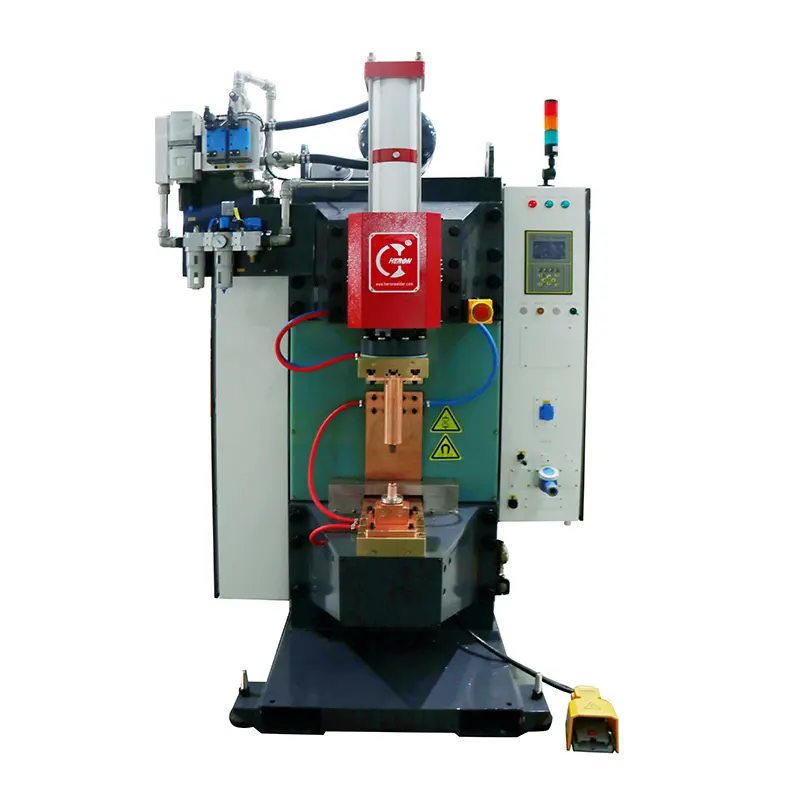เชื่อมอย่างไรไม่ให้เสียรูป?
วิธีป้องกันและลดการเปลี่ยนรูปในการเชื่อมต้องคำนึงถึงการออกแบบกระบวนการเชื่อมและเอาชนะการเปลี่ยนแปลงของวงจรร้อนและเย็นระหว่างการเชื่อม การหดตัวไม่สามารถกำจัดได้ แต่สามารถควบคุมได้ วิธีการลดการเสียรูปจากการหดตัวมีดังนี้
1. อย่าบัดกรีมากเกินไป
การเติมโลหะมากขึ้นจะทำให้เกิดแรงเสียรูปที่จุดเชื่อมมากขึ้น การกำหนดขนาดการเชื่อมอย่างถูกต้องไม่เพียงแต่จะทำให้การเชื่อมเสียรูปน้อยลงเท่านั้น แต่ยังช่วยประหยัดวัสดุและเวลาในการเชื่อมอีกด้วย ปริมาณการเชื่อมโลหะที่เติมรอยเชื่อมควรน้อยที่สุด และการเชื่อม ตะเข็บควรแบนหรือนูนเล็กน้อย โลหะเชื่อมที่มากเกินไปจะไม่เพิ่มความแข็งแรง แต่จะเพิ่มแรงหดตัวและเพิ่มความผิดปกติของการเชื่อมแทน
2. รอยเชื่อมขัดจังหวะ
อีกวิธีหนึ่งในการลดปริมาณการเติมรอยเชื่อมคือการใช้การเชื่อมแบบไม่สม่ำเสมอมากขึ้น ตัวอย่างเช่น แผ่นเสริมแรงในการเชื่อม การเชื่อมเป็นระยะสามารถลดปริมาณการเติมรอยเชื่อมได้ถึง 75% ในขณะเดียวกันก็รับประกันความแข็งแรงที่ต้องการอีกด้วย
3. ลดรอยเชื่อม
ใช้ลวดเชื่อมหนา การเชื่อมโดยใช้ลวดเชื่อมน้อยจะดีกว่าการใช้ลวดเชื่อมแบบบาง การเสียรูปในการเชื่อมด้วยการเชื่อมหลายรอบจะมีขนาดเล็กลง เมื่อมีการเชื่อมหลายรอบ การหดตัวที่เกิดจากการเชื่อมแต่ละครั้งจะเพิ่มการหดตัวของรอยเชื่อมสะสม ผ่านการเชื่อมน้อยลง กระบวนการเชื่อมด้วยอิเล็กโทรดที่หนากว่าจะดีกว่าการใช้ลวดเชื่อมจำนวนมาก กระบวนการเชื่อมของเม็ดเชื่อมและอิเล็กโทรดแบบบางมีผลดีกว่า หมายเหตุ: ใช้ลวดเชื่อมหนา เชื่อมผ่านน้อย หรือลวดเชื่อมบาง กระบวนการเชื่อมของการเชื่อมหลายรอบขึ้นอยู่กับวัสดุ โดยทั่วไปแล้ว เหล็กกล้าคาร์บอนต่ำ 16Mn และวัสดุอื่นๆ จะเหมาะกับลวดเชื่อมที่มีความหนา การเชื่อมน้อย การเชื่อมแบบ Pass สเตนเลส เหล็กคาร์บอนสูง และวัสดุอื่นๆ เหมาะสำหรับการเชื่อมลวดละเอียด การเชื่อมแบบหลายรอบ
4. เทคโนโลยีป้องกันการเสียรูป
ก่อนการเชื่อม ชิ้นส่วนจะถูกงอล่วงหน้าหรือเอียงไปในทิศทางตรงกันข้ามกับการเสียรูปของการเชื่อม (ยกเว้นการเชื่อมเหนือศีรษะหรือการเชื่อมในแนวตั้ง) จำเป็นต้องกำหนดจำนวนการเสียรูปย้อนกลับที่กำหนดไว้ล่วงหน้าผ่านการทดสอบ ชิ้นส่วนเชื่อมก่อนการดัด การตั้งค่าล่วงหน้า หรือก่อนการโค้งจะใช้เครื่องจักรย้อนกลับ แรง ซึ่งเป็นวิธีง่ายๆ ในการชดเชยความเครียดในการเชื่อม เมื่อชิ้นงานถูกตั้งค่าล่วงหน้า จะเกิดการเสียรูปซึ่งทำให้เกิดความเค้นหดตัวของชิ้นงานและแนวเชื่อมตรงกันข้าม การเสียรูปที่กำหนดไว้ล่วงหน้าก่อนการเชื่อมและการเสียรูปหลังการเชื่อมจะหักล้างกัน ทำให้ชิ้นงานที่เชื่อมเป็นระนาบในอุดมคติ
อีกวิธีหนึ่งที่ใช้กันทั่วไปในการปรับสมดุลแรงหดตัวคือการวางชิ้นงานที่เชื่อมเหมือนกันไว้ตรงข้ามกันแล้วจับยึด วิธีนี้สามารถใช้ในการดัดเบื้องต้นได้ด้วย โดยการวางเวดจ์ในตำแหน่งที่เหมาะสมบนชิ้นงานก่อนทำการหนีบ
ชิ้นงานเชื่อมสำหรับงานหนักพิเศษสามารถสร้างแรงสมดุลที่ต้องการได้ เนื่องจากความแข็งแกร่งของชิ้นงานหรือตำแหน่งที่ชิ้นส่วนทั้งสองอยู่ร่วมกัน หากไม่สร้างแรงสมดุลเหล่านี้ จะต้องใช้วิธีการอื่นเพื่อสร้างสมดุลแรงหดตัวของวัสดุเชื่อมเพื่อให้บรรลุวัตถุประสงค์ในการตัดกัน แรงสมดุลสามารถ เป็นแรงหดตัวอื่นๆ แรงยึดเหนี่ยวทางกลที่เกิดขึ้นจากการใช้อุปกรณ์จับยึดเครื่องมือ แรงยึดเหนี่ยวที่เกิดขึ้นจากการประกอบและลำดับการเชื่อมของส่วนประกอบ แรงยึดเหนี่ยวที่เกิดจากแรงโน้มถ่วง
5.ลำดับการเชื่อม
กำหนดลำดับการประกอบที่เหมาะสมตามรูปแบบโครงสร้างของชิ้นงาน เพื่อให้โครงสร้างชิ้นงานหดตัวที่ตำแหน่งเดียวกัน สร้างร่องสองด้านที่กึ่งกลางและแกนของชิ้นงาน ใช้การเชื่อมหลายชั้น และกำหนดลำดับการเชื่อมสองด้าน ใช้ความไม่ต่อเนื่องในการเชื่อมเนื้อ ระหว่างการเชื่อม การหดตัวในการเชื่อมรอบแรกจะถูกสมดุลด้วยการหดตัวในการเชื่อมรอบที่สอง ฟิกซ์เจอร์เครื่องมือสามารถยึดชิ้นงานในตำแหน่งที่ต้องการ เพิ่มความแข็งแกร่ง และลดความผิดปกติของการเชื่อม วิธีการนี้ใช้กันอย่างแพร่หลายกับชิ้นงานขนาดเล็กหรือส่วนประกอบขนาดเล็ก การเชื่อมเนื่องจากความเครียดในการเชื่อมที่เพิ่มขึ้นจึงเหมาะสำหรับโครงสร้างเหล็กกล้าคาร์บอนต่ำที่มีความเป็นพลาสติกที่ดีเท่านั้น
6. ขจัดแรงหดตัวหลังการเชื่อม
การน็อคเป็นวิธีหนึ่งในการต่อต้านแรงหดตัวของแนวเชื่อม เช่นเดียวกับที่แนวเชื่อมกำลังเย็นตัวลง การเคาะจะทำให้รอยเชื่อมยืดและบางลง จึงช่วยลดความเครียด (การเสียรูปแบบยืดหยุ่น) อย่างไรก็ตามเมื่อใช้วิธีนี้ต้องระวังไม่ให้รอยเชื่อม รากไม่สามารถกรีดได้เนื่องจากอาจเกิดรอยแตกร้าวระหว่างการกรีด โดยทั่วไป ไม่สามารถใช้การต๊าปกับเม็ดเชื่อมฝาได้
เนื่องจากชั้นเคลือบอาจมีรอยร้าวจากการเชื่อมซึ่งจะส่งผลต่อการตรวจจับรอยเชื่อมและทำให้เกิดการแข็งตัว ดังนั้นการใช้เทคโนโลยีจึงมีจำกัด และยังมีตัวอย่างที่ต้องต๊าปรอยเชื่อมเฉพาะภายในรอยเชื่อมหลายชั้นเท่านั้น (งานเชื่อมไพรเมอร์ และ (ไม่รวมการเชื่อมแบบครอบ) เพื่อแก้ไขปัญหาการเสียรูปหรือรอยแตกร้าว การอบชุบด้วยความร้อนก็เป็นวิธีหนึ่งในการขจัดแรงหดตัว การควบคุมอุณหภูมิที่สูงและการระบายความร้อนของชิ้นงาน บางครั้งชิ้นงานเดียวกันก็จะถูกหนีบกลับไปด้านหลัง การเชื่อมโดยใช้เงื่อนไขการวางแนวนี้เพื่อขจัดความเค้น ลดความเค้นตกค้างในชิ้นงานให้เหลือน้อยที่สุด
7. ลดเวลาในการเชื่อม
การทำความร้อนและความเย็นเกิดขึ้นระหว่างการเชื่อม และต้องใช้เวลาในการส่งความร้อนด้วย ดังนั้นปัจจัยด้านเวลายังส่งผลต่อการเปลี่ยนรูปด้วย โดยทั่วไปหวังว่าการเชื่อมชิ้นงานขนาดใหญ่จะแล้วเสร็จโดยเร็วที่สุดก่อนการขยายตัวเนื่องจากความร้อน กระบวนการเชื่อม เช่น ชนิดและขนาดของเส้นเชื่อม และกระแสเชื่อม ความเร็วในการเชื่อม ฯลฯ ส่งผลต่อระดับการหดตัวและการเสียรูปของชิ้นงานที่เชื่อม การใช้อุปกรณ์เชื่อมด้วยเครื่องจักรช่วยลดเวลาในการเชื่อมและปริมาณการเสียรูปที่เกิดจากความร้อน
บทความนี้เน้นการเชื่อมเหล็กกำลังสูง โดยอธิบายคุณลักษณะต่างๆ เช่น ความแข็งแรงสูงและความเหนียวดี และชี้ให้เห็นประเด็นสำคัญทางเทคนิค เช่น การเตรียมก่อนการเชื่อมและการเลือกวิธีการ โดยเน้นย้ำถึงการประยุกต์ใช้การเชื่อมด้วยความต้านทาน รวมถึงคุณลักษณะทางเทคนิค ขอบเขตการใช้งาน ประเด็นสำคัญในการปฏิบัติงาน ปัญหาและวิธีแก้ปัญหา ซึ่งเป็นแนวทางที่สำคัญสำหรับงานเชื่อมที่เกี่ยวข้อง
บทความนี้ศึกษาการเชื่อมเหล็กขึ้นรูปร้อน โดยให้รายละเอียดเกี่ยวกับความแข็งแรงสูงเป็นพิเศษ ความแม่นยำที่ดี แต่การเชื่อมได้ไม่ดี ประเด็นสำคัญ ได้แก่ การเลือกวัสดุ การปรับพารามิเตอร์ให้เหมาะสม มีการแนะนำวิธีการหลักๆ เช่น การต้านทาน เลเซอร์ การเชื่อมอาร์ก นอกจากนี้ยังครอบคลุมถึงความท้าทายต่างๆ เช่น รอยแตกร้าวและวิธีแก้ปัญหาด้วย
บทความนี้เน้นไปที่อะลูมิเนียมอัลลอยด์ อันดับแรกจะระบุคุณลักษณะต่างๆ เช่น น้ำหนักเบา ความแข็งแรงสูง ความต้านทานการกัดกร่อน ฯลฯ จากนั้นจะอธิบายรายละเอียดวิธีการเชื่อมทั่วไป เช่น การเชื่อมด้วยความต้านทาน การเชื่อม TIG และการเชื่อม MIG/MAG พร้อมด้วยคุณสมบัติและขอบเขตการใช้งาน นอกจากนี้ยังวิเคราะห์ความท้าทายด้านเทคนิคในการเชื่อมรวมถึงการเสียรูป ความพรุน ฟิล์มออกไซด์ และการอ่อนตัวของข้อต่อ และเสนอวิธีแก้ปัญหาที่เกี่ยวข้อง โดยรวมแล้ว เน้นย้ำถึงความสำคัญของการเชื่อมโลหะผสมอลูมิเนียมในอุตสาหกรรมสมัยใหม่ ความจำเป็นในการฝึกฝนเทคนิคการเชื่อมที่เหมาะสม และมุ่งหวังที่จะเห็นนวัตกรรมและความก้าวหน้าของเทคโนโลยีการเชื่อมโลหะผสมอลูมิเนียมด้วยการพัฒนาทางวิทยาศาสตร์และเทคโนโลยี
บทความนี้เน้นไปที่เหล็กกล้าไร้สนิมเป็นหลัก ขั้นแรกจะอธิบายคุณลักษณะของสเตนเลสสตีลอย่างละเอียด รวมถึงสเตนเลสประเภทต่างๆ เช่น สเตนเลสออสเทนนิติก มาร์เทนซิติก เฟอร์ริติก และสเตนเลสดูเพล็กซ์ และคุณสมบัติของสเตนเลส เช่น ความต้านทานการกัดกร่อน จากนั้นจะนำเสนอวิธีการเชื่อมหลักๆ เช่น การเชื่อมด้วยความต้านทาน การเชื่อมอาร์กด้วยมือ การเชื่อมแบบป้องกันแก๊ส การเชื่อมด้วยเลเซอร์ และอื่นๆ ตลอดจนขอบเขตการใช้งานและจุดปฏิบัติงาน นอกจากนี้ยังวิเคราะห์ปัญหาทางเทคนิคในการเชื่อม เช่น การแตกร้าวจากความร้อน การกัดกร่อนตามขอบเกรน การเสียรูปของการเชื่อม และความพรุน และเสนอวิธีแก้ปัญหาที่เกี่ยวข้อง โดยรวมแล้วเน้นย้ำถึงความซับซ้อนและความสำคัญของการเชื่อมสแตนเลส
บทความนี้จะแนะนำระบบปืนตอกหมุดด้วยหุ่นยนต์ FSPR เพื่อเป็นวิธีแก้ปัญหาความท้าทายที่อุตสาหกรรมยานยนต์ต้องเผชิญ
โดยเฉพาะการประกอบชิ้นส่วนหลังคารถยนต์ใหม่ที่ทำจากชิ้นงานหลายชั้นที่มีรูปทรงแตกต่างกัน ระบบใช้กระบอกสูบเซอร์โวเพื่อส่งแรงตอกหมุดน้ำหนักสูงอย่างแม่นยำ เสริมด้วยการตรวจสอบแบบเรียลไทม์และการวิเคราะห์ข้อมูล แอปพลิเคชันที่ประสบความสำเร็จได้รับการแก้ไขแล้ว
ความท้าทายทางเทคนิค เพิ่มความน่าเชื่อถือของการเชื่อมต่อแบบตรึง มีส่วนทำให้ตัวถังรถยนต์มีน้ำหนักเบา และขับเคลื่อนความก้าวหน้าทางเทคโนโลยีในอุตสาหกรรมการผลิตยานยนต์
ผู้ติดต่อ: คริสติน่าหลิว
โทร: 86 20 87813325 / 86 20 87819588 / 86 20 87815075
แฟกซ์แฟ็กซ์: 86 20 87813346
ที่อยู่: No.63 Xin Yi Road, กวางโจว, กวางตุ้ง จีน 510990














